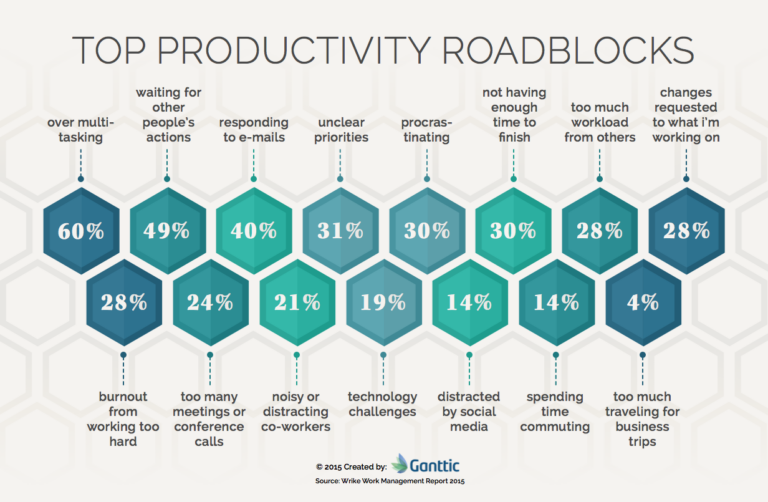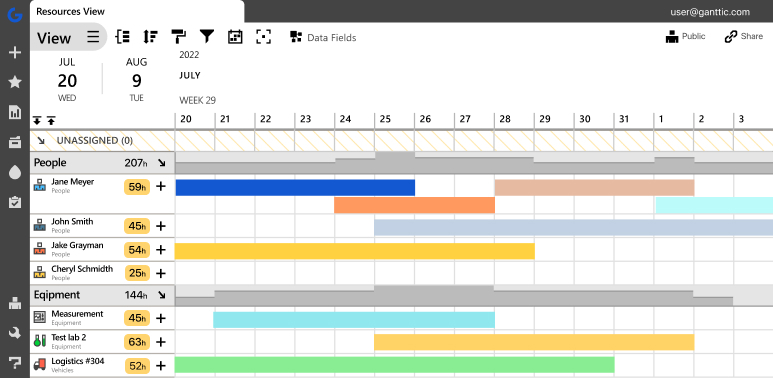Managers have to deal with making sure their projects get delivered on time. But that’s almost impossible when there’s literally millions of things that can go wrong and deter progress. To combat this, we put together an infographic on the top 15 productivity roadblocks in project management. As well as some of the best ways to push through these challenges and get your project and team back on track.
What Deters Productivity?
Modern society puts a lot of emphasis on productivity. Not only do we always have to be on the move, but everything we engage in has to be working towards something.
For project portfolio managers, this is often the case. And actually for them, this is the most successful way to think about their job. But for everyone else, this way of thinking can often have serious side effects. Especially if things don’t go as planned. Which is often the case.
In the infographic below, we highlight the top roadblocks to project management productivity. With 15 common issues people report hindering their workflow.

Solving Productivity Roadblocks in Project Management
Here we’ll go into more detail some of these productivity roadblocks as well as some techniques on how to solve them.
Over Multi-tasking
Juggling too many tasks at the same time is terrible for productivity. And due to multitasking, a whopping 60% of employees aren’t able to get any meaningful work done.
How to solve it:
Science has repeatedly proven that humans can’t effectively do 2 things at once. So stop with multi-tasking, already! Not only does it harm the quality of work, but it’s a serious damper on productivity. Allow employees to focus on one thing at a time and you will see the spike in them actually finishing their work. If you do need to schedule concurrent tasks for your team, then make sure there’s proper lag time in between them.
Waiting on Others
Patience is necessary for effective teamwork. But that doesn’t give team members the right to hold others’s time hostage. That’s what happens for the 49% of employees who must wait on other people’s actions to complete their own work.
How to solve it:
Create a clear workflow for your team with dependencies. These indicate exactly which tasks need to be finished before moving on to the next.
Responding to Emails
Being in constant contact is both a blessing and a curse. For productivity it’s seemingly more the latter. That’s because responding to emails take up so much time that 40% of employees say their projects are affected by it.
How to solve it:
Obviously there’s many time sensitive issues throughout the day that require an email. But instead of sending one to every single team member that a project is about to start, or emailing out the latest version of your project spreadsheet, consider how you can automate the process.
Then maybe you can start thinking about getting to inbox zero.
Too Many Changes & Unclear Priorities
Changes are part and parcel of project management. But it’s hard to be productive when you don’t know what it is you’re supposed to be doing. And for 31% of respondents, unclear priorities are a major productivity roadblock to project success. Couple this with 28% reporting that their roadblocks come from too many new management requests. Plus another 28% who are dismayed by frequent schedule changes.
How to solve it:
The most effective project managers are clear about roles, deadlines, and tasks. But even they may need a helping hand from time to time. That’s why Gantt charts are the number 1 tool of PMs. These charts visually breakdown everything that team members need to be working on.
And if you share the online charts with your team, they can stay up to date on all the changes to the schedule. So there’s not any confusion and priorities are always crystal clear.
While checking Facebook once in a while seems to be a good method of taking a break, it might actually be taking far longer than appropriate. That’s why we see 30% of respondents blaming procrastination on their low productivity. And also why another 14% of productivity problems come from being distracted by social media.
How to solve it:
You can’t make your team quit Facebook. But you can find some new ways to motivate them at work. Research has shown that giving employees extra challenges throughout the day can actually increase productivity. You can also check out a few tips on boosting engagement here.
Time Constraints & Burnout
Deadlines are important to getting work done. But they have the opposite effect when they are unrealistic. That may be why 30% of employees suffer from stunted productivity because they don’t have enough time to finish their work. This can lead to some serious repercussions. Since 28% of workers blame lower productivity on burnout from working too hard.
How to solve it:
Sounds like it’s time to start implementing resource management techniques into the project planning process. By tracking resource utilization, managers can see exactly how much time projects and tasks are taking. This helps to make more accurate forecasts for the project schedule. And also ensures that
Office Distractions
The last few years have shown us that work doesn’t need to happen at the office. And considering that 21% of people reported lower productivity from noisy or distracting co-workers, it should really come as no surprise. However, to compensate, make sure you aren’t bombarding the team with Zoom calls. Since 24% of those polled see their productivity decrease after too many meetings or conference calls.
How to solve it:
Hybrid workspaces are the latest trend that can aim to solve the problem between 40 hours at the office and work-from-home burnout. And armed with the right tools, you can successfully avoid those in-office distractions as well as spending too much time in your virtual meetings.
Technology Challenges
The world has never been more connected. But that doesn’t mean that there aren’t still issues. And 19% of productivity shortcomings come from technology challenges.
How to solve it:
Technology challenges can be solved by first understanding how tech-savvy each employee is, then using this information, a company is able to decide whether to provide workshops for the less tech-savvy or arrange tech-mentors. Once that’s done, you can decide the best project management software to implement for your team.
You also need to worry about fast computers for your employees. Because, for example, if the mac is slow, then work tasks will take a long time.
Travel & Commuting
Commutes can be a killer. Daily travel to and from the office can eat up time, resources, and wear down mental health. Not to mention the impact it has on productivity – as 14% say that commutes are responsible for achieving less. For international companies traveling can be even harder, since it’s already hard to stay connected. That’s why we see 4% of people reporting that productivity is hindered by too much traveling for business trips.
How to solve it:
Being face-to-face is great for some things, but if it’s really harming your project success, maybe scale back on the travel. Look into some tips for virtual team project management. Or some tools that help virtual teams succeed without being in the same office.
Low Productivity Has To Go

More often than not, these productivity barriers are a reflection of a greater issue that has to be addressed on every scale. While it may seem that these employees are not motivated enough to find out their priorities and stop procrastinating, the problem comes from deeper within – motivation.
Managers can solve this at a snap of the fingers by introducing a streamlining system to help employees determine their priorities and provide them with a go-to planner to keep track of their work productivity. Using such a tool would also decrease the number of people waiting for other people’s actions to complete their job.
If a task isn’t done, everyone can clearly see it and work on other things to maximize productivity. Having too much workload from others, suffering burnout from working too hard, having too many meetings or conference calls are all the result of poor capacity management. Ganttic has the feature of calculating utilization percentages to keep tasks equally divided among resources.
Once everyone in the team is clear on everyone’s responsibilities and priorities, these unnecessarily high statistics will noticeably decrease. See for yourself with a personal demo of Ganttic.